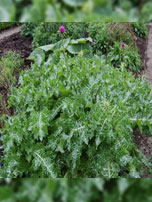SHAHEED KARTAR SINGH SARABHA AYURVEDIC MEDICAL COLLEGE & HOSPITAL
Affiliated to Guru Ravidas Ayurved University, Hoshiarpur Punjab
Affiliated to Guru Ravidas Ayurved University, Hoshiarpur Punjab

Botanical Name : Silybum marianum
Family : Asteraceae
Introduction :
Due to unmatched availability of chemical diversity, natural products from medicinal herbs (as pure compounds or standardized extracts) provide unlimited opportunities for therapeutic usage. Botanical preparations for medicinal purposes contain various types of bioactive compounds, of which natural polyphenols have attracted increasing attention as potential agents for the prevention and treatment of liver diseases. Among them, flavonolignans (i.e., naturally occurring hybrid molecules biogenetically originating from flavonoids and lignans) are the most common class of compounds present in milk thistle extract that has long been used for hepatoprotection. Besides this, many other health promoting actions of the extract give it the opportunity to be an interesting alternative source for pharmaceutical and medicinal applications.
Names in different Indian languages :
English: cardus marianus, milk thistle, blessed milkthistle, Marian thistle, Mary thistle, Saint Mary’s thistle, Mediterranean milk thistle, variegated thistle, Scotch thistle
Binomial Name :
Silybum marianum (L.) Gaertn.
Synonyms :
Carduus marianus L.
Chemical constituents :
Traditional milk thistle extract is made from the seeds, which contain approximately 4–6% silymarin. The extract consists of about 65–80% silymarin (a flavonolignan complex) and 20–35% fatty acids, including linoleic acid. Silymarin is a complex mixture of polyphenolic molecules, including seven closely related flavonolignans (silybin A, silybin B, isosilybin A, isosilybin B, silychristin, isosilychristin, silydianin) and one flavonoid (taxifolin). Silibinin, a semipurified fraction of silymarin, is primarily a mixture of 2 diastereoisomers, silybin A and silybin B, in a roughly 1:1 ratio.
Morphology :
Grow in average, moderately fertile, well-drained soils in full sun. Tolerates poor soils. Remove seed heads promptly after bloom to prevent self-seeding. This plant is a biennial that can be grown as an annual. For growth as a biennial, sow seed directly in the garden from May to August (flowers will not appear until the second year). For growth as an annual, sow seed indoors in March for planting outside at last spring frost date (flowers will appear in late summer followed by seed). Flowering plants may spread by self-seeding unless flowers are promptly deadheaded after bloom.
Distribution & Habitat :
S. marianum is native to the Mediterranean region of Europe including Greece (mostly in Crete), east into Iran and Afghanistan. It is possibly native near the coast of southeast England. S. marianum has been widely introduced outside its natural range, for example into North America, Hawaii, Australia, New Zealand, Colombia where it is considered an invasive weed.
Milk thistle has been potentially observed to modify fire regimes in its invasive range. Its invasion into new habitats may also be encouraged by fire.
The “giant thistle of the Pampas” reported by Darwin in the Voyage of the Beagle is thought by some to be Silybum marianum.
Uses :
Hepatoprotective activity
Anticancer activity
Anti-inflammatory and immunomodulatory activity
Neuroprotective potential
Lactogenic effect
